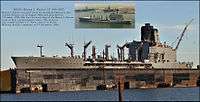USNS Henry J. Kaiser (T-AO-187)
USNS Henry J. Kaiser (T-AO-187) is a United States Navy replenishment oiler and the lead ship of her class. She is operated by Military Sealift Command and therefore has a "USNS" prefix for United States Naval Ship. She is named for Henry J. Kaiser (1882–1967), an American industrialist and shipbuilder.
.jpg) USNS Henry J. Kaiser (T-AO-187) at Hampton Roads, Virginia | |
| History | |
|---|---|
| Name: | USNS Henry J. Kaiser |
| Namesake: | Henry J. Kaiser (1882–1967) |
| Awarded: | 12 November 1982 |
| Builder: | Avondale Shipyard, Inc., New Orleans, Louisiana |
| Laid down: | 22 August 1984 |
| Launched: | 5 October 1985 |
| In service: | 19 December 1986 |
| Identification: |
|
| Status: | Full operation |
| General characteristics | |
| Class and type: | Henry J. Kaiser-class fleet replenishment oiler |
| Type: | Fleet replenishment oiler |
| Tonnage: | 31,200 DWT |
| Displacement: |
|
| Length: | 677 ft (206 m) |
| Beam: | 97 ft 5 in (29.69 m) |
| Draft: | 35 ft (11 m) maximum |
| Installed power: |
|
| Propulsion: | Two shafts with controllable pitch propellers |
| Speed: | 20 knots (37 km/h; 23 mph) |
| Capacity: |
|
| Complement: | 103 (18 civilian officers, 1 U.S. Navy officer, 64 merchant seamen, 20 U.S. Navy enlisted personnel) |
| Armament: |
|
| Aviation facilities: | Helicopter landing platform |
| Notes: |
|
Construction and delivery
Henry J. Kaiser was laid down by Avondale Shipyard, Inc., in New Orleans, Louisiana, on 22 August 1984 and launched on 5 October 1985. She was the lead ship of the Henry J. Kaiser class of fleet replenishment oilers. She entered non-commissioned U.S. Navy service with the Military Sealift Command on 19 December 1986.
Service history
Following delivery, the Henry J. Kaiser operated out of Norfolk, Virginia, as part of the Second Fleet. In 1995, she was forward deployed to Diego Garcia in the Indian Ocean as part of the pre-positioning fleet. In 2002, she was transferred to the Third Fleet and placed in reduced operating status in Portland, Oregon. She was activated briefly in 2003 when two other oilers were simultaneously undergoing planned maintenance. In 2005, she was re-activated to full service as part of the Third Fleet, where she remains to this day.

Great Green Fleet
During RIMPAC 2012, Kaiser delivered 900,000 gallons of a 50–50 blend of advanced biofuels and traditional petroleum-based fuel to the U.S. Navy aircraft carrier USS Nimitz (CVN 68) strike group. The fuel delivery is part of the Navy's Great Green Fleet demonstration, which allows the Navy to test, evaluate and demonstrate the cross-platform utility and functionality of advanced biofuels in an operational setting. This will achieve one of the five energy goals established by Secretary of the Navy Ray Mabus, to demonstrate a Great Green Fleet in local operations by 2012.[1]
References
This article includes information collected from the Naval Vessel Register, which, as a U.S. government publication, is in the public domain. The entry can be found here.
- "USNS Henry J. Kaiser Delivers Biofuel for RIMPAC's Great Green Fleet Demo". Maritime-executive.com. Retrieved 4 October 2013.
- "RIMPAC 2012". Cpf.navy.mil. 3 July 2012. Retrieved 4 October 2013.
- "USNS Henry J. Kaiser delivers biofuel for RIMPAC's Great Green Fleet demo". Msc.navy.mil. 17 July 2012. Retrieved 4 October 2013.
- http://www.globalsecurity.org/military/library/news/2012/06/mil-120613-nns04.htm
External links
| Wikimedia Commons has media related to IMO 8302416. |
- NavSource Online: Service Ship Photo Archive: USNS Henry J. Kaiser (T-AO-187)
- USNS Henry J. Kaiser (T-AO 187)
- Wildenberg, Thomas (1996). Gray Steel and Black Oil: Fast Tankers and Replenishment at Sea in the U.S. Navy, 1912–1995. Annapolis, Maryland: Naval Institute Press. Retrieved 28 April 2009.